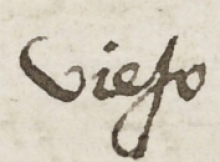huehuetl (Mdz70r)
This iconographic example from the Codex Mendoza, folio 70 recto, is a standing drum with a jaguar pelt on the top and a horizontal turquoise-colored band above the legs. The legs have a zigzag or stepped cutout pattern that is also turquoise in color. The main part of the drum has a pattern that is reminiscent of either stone or wood.
Stephanie Wood
This gloss with this drum does not say "tambor," as might be expected. Rather, it says "viejo" (old man), which is the translation for huehue, not huehuetl. Thus, perhaps the person writing viejo was a Nahua who was thinking of how the Nahuatl words for drum and old man were homophonic.
Stephanie Wood
viejo
viejo
Stephanie Wood
by 1553 at the latest
Stephanie Wood
drums, huehuetes, atabal, atabales, vertical, madera
huehue, elder
huehue(tl), standing drum
Codex Mendoza, folio 70 recto, https://digital.bodleian.ox.ac.uk/objects/2fea788e-2aa2-4f08-b6d9-648c00..., image 150 of 188.
Original manuscript is held by the Bodleian Libraries, University of Oxford, MS. Arch. Selden. A. 1; used here with the UK Creative Commons, “Attribution-NonCommercial-ShareAlike 3.0 License” (CC-BY-NC-SA 3.0)








